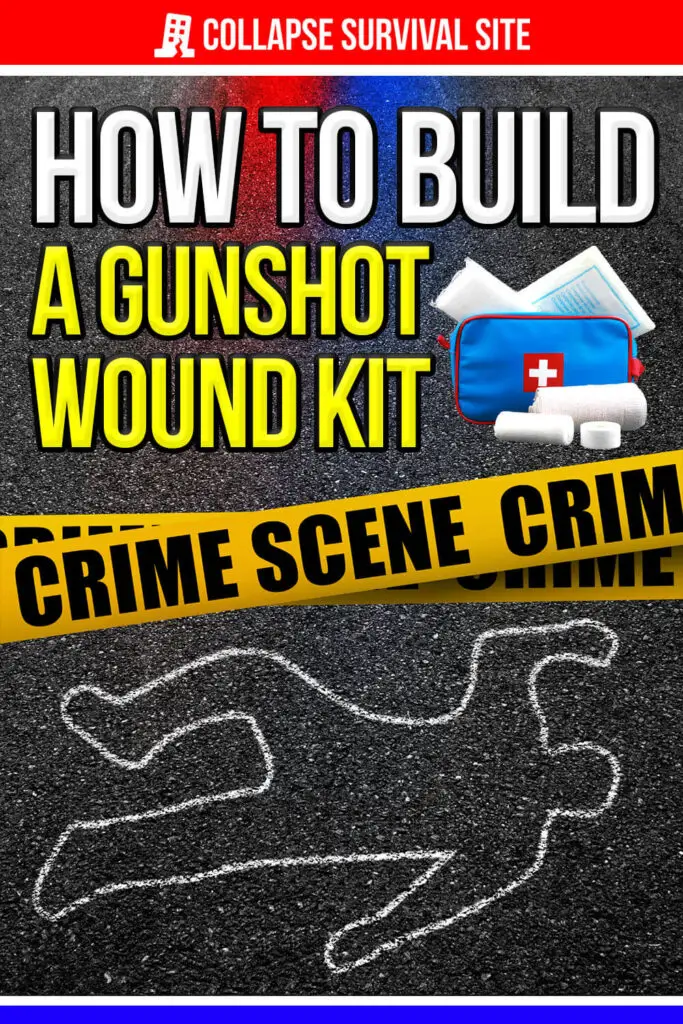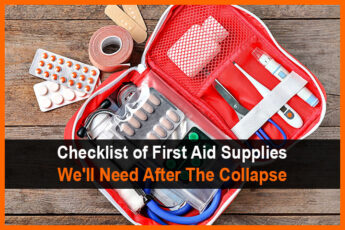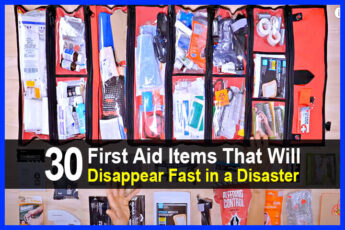Estimated reading time: 12 minutes
In the midst of any societal collapse the rule of law is often replaced by the rule of the streets. In collapsing countries around the world, guns inevitably became the dominant enforcer and primary weapon accompanying looters, arsonists and general violence against a reeling population.
At a time when law enforcement and even the military are overwhelmed it will become necessary for many to defend themselves and their homes but the outcome is usually inevitable. Many people will get shot. Too many as innocent victims of a society torn apart by fear.
What always complicates any degree of injury in a time of societal collapse is the collapse of traditional support systems. Hospitals and doctors will be inundated with injuries and illness and while the most seriously injured may inevitably receive some level of care it could take time and ultimately take lives.
Many people preparing for a possible collapse of society think ahead and stock both first aid equipment and take the time to learn about basic medical treatments. But how many of us have given any thought to the trauma of a gunshot wound and the proper ways to treat it both in the short-term and the long-term.
Want to save this post for later? Click Here to Pin It On Pinterest!
It Goes Beyond Traditional Wound Care
Most deep wounds are caused by cuts into skin and muscle from sharp edges and objects. Some wounds are puncture wounds from pointed tools or protruding materials. In spite of their severity, those types of wounds aren’t as traumatic as a gunshot wound.
Gunshot wounds often result in significant bleeding, muscle and nerve damage, severed arteries and veins, shattered bones, traumatic injuries to organs, large and deep lacerations and intense pain and shock. The ability to treat someone immediately while awaiting or transporting to professional medical care, or the need to care for them without the aid of doctors or hospitals may be a desperate and necessary task in desperate times.
Assembling the Knowledge for Treatment
Before we get into the contents of a gunshot wound kit it makes a lot of sense to assemble the information you need to treat the varying levels of injury cause by a gunshot. This could include online classes and videos but most importantly, books on the shelf.
Now would be a good time to study and learn some of the online information but after any level of societal collapse the ability to access online information may be limited if not impossible. Books will always be there and are portable in the event of a bug out.
It should be no surprise that military organizations around the world have dedicated a lot of time to covering gunshot wound treatments in their first aid field manuals. Here are a few to consider:
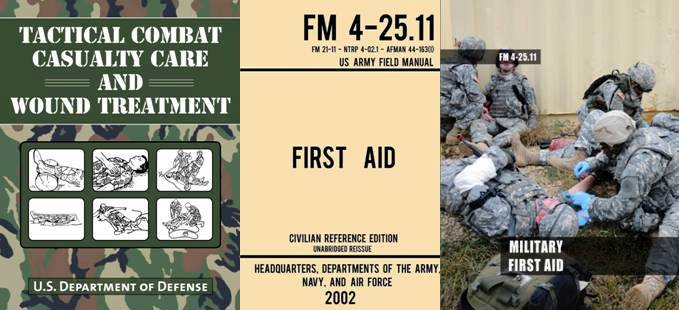
Tactical Combat Casualty Care and Wound Treatment
- Tactical field care covering the realities of first aid in hostile or primitive environments.
- Field dressing basics from bleed stops to dressings for transport.
- Applying pressure dressing to stop intense bleeding.
- Treating burns short-term and long-term.
- Treating inhalation injuries due to smoke, gas, flames or chemicals.
First Aid: U.S. Army Field Manual
Contents include basic first aid; evaluating injuries and casualties; breathing and airway; bleeding and wound protection; shock; various wounds on specific parts of the body; bandages; fractures and splinting; burns; heat and cold injuries; insects, bites, and stings; nuclear/biological/chemical situations; psychological and mental stress considerations for first aid; first aid kids and equipment; carries, transport, and airlifts; and theories of first aid and rescue.
Military First Aid
This manual meets the first aid training needs of individual service members. Because medical personnel will not always be readily available, the nonmedical service members must rely heavily on their own skills and knowledge of life-sustaining methods to survive on the integrated battlefield.
This publication outlines both self-aid and aid to other service members (buddy aid). More importantly, it emphasizes prompt and effective action in sustaining life and preventing or minimizing further suffering and disability
When There Is No Doctor
In addition to military field manuals it’s worth considering books about emergency medical treatments specifically designed for everyday people who have to deal with a medical emergency, including gunshot wounds, on their own.
These books are written for situations where there is no doctor and any level of medical treatment is performed by a family member or community member who has dedicated themselves to developing advanced medical skills.
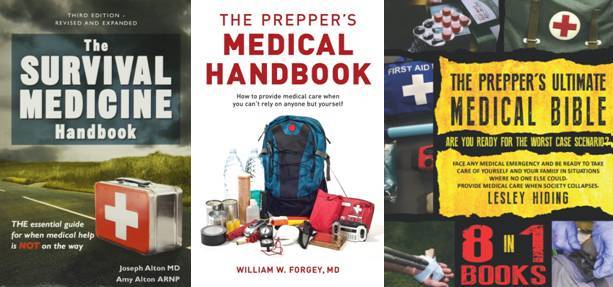
The Survival Medicine Handbook: THE Essential Guide for When Medical Help is NOT on the Way
This book is written by America’s top medical preparedness experts: Joe Alton, MD, and Amy Alton, ARNP. Their mission: to put a medically prepared person in every family for when medical help is not on the way. Using decades of medical experience, they address, in plain language, dozens of medical issues associated with surviving disasters and epidemics.
The Altons also discuss the medical supplies needed to become a medical asset to your family and community as well as alternative and natural strategies for when pharmaceuticals aren’t available.
The Prepper's Medical Handbook
This book provides the basis of prevention, identification, and long-term management of survivable medical conditions and can be performed with minimal training.
It helps you identify sources of materials you will need and should stock-pile, it discusses storage issues, and directs you to sources for more complex procedures that require advanced concepts of field-expedient techniques used by trained medical persons such as surgeons, anesthesiologists, dentists, or midwifes and obstetricians.
- Different types of wounds – small, major and hemorrhagic wounds, gunshot and knife wounds
- Survival medicine – principle of medical preparedness and importance of becoming a medical resource
- Issues you can face in emergency situations – by knowing what you can expect you can know better how to behave
- Mass casualty incidents – what behaviors should be adopted in mass incidents, such as triage and immediate first aid
- A physical exam – how to identify the health status of an injured person and then decide whether or not to intervene
- Sanitation – how to make sure that cleaning does not become a problem if there are infections in the area
Contents of a Gunshot Wound Kit
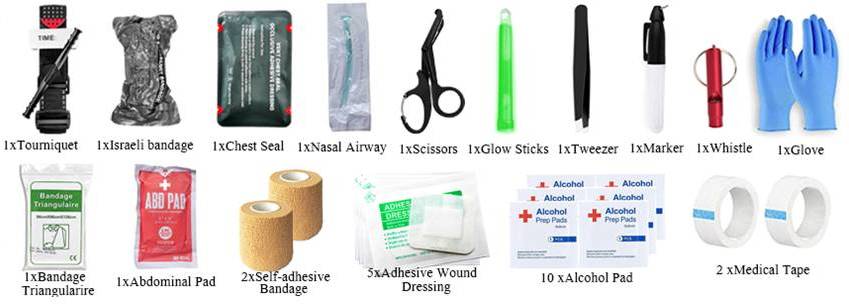
The severity of a gunshot wound varies from flesh wounds to penetration wounds to the trunk of the body to wounds that fractured bones and/or severed arteries in limbs. The immediate need in most cases is to stop the bleeding, treat the victim for shock and assess their condition as care continues to be administered.
As a result, many of the items in a gunshot wound kit are directly involved with managing blood loss including:
- 1 – A full-size combat tourniquet to restrict the flow of blood through veins and arteries on legs and arms.
- 10 – Israeli Bandages. This Emergency Bandage or “Israeli bandage” is a specially designed, first-aid device that is used to stop bleeding from hemorrhagic wounds caused by traumatic injuries in pre-hospital emergency situations
- 2 – Large Chest Seal Bandages to close sucking chest wounds due to lung penetration
- 12 – Z-Fold Compressed Gauze to pack wounds
- 36 – Rolls of sterile gauze
- 100 – Large 2×2 and 4×4-inch gauze pads
- 100 pair – Nitrile sterile gloves
- 400 – BZK antiseptic towelettes to clean areas around a wound
- 3 rolls – Surgical tape to bind gauze bandages and larger bandages
- 10 – Elastic bandages to wrap and compress gauze around wounds and bind the wounds to the body or limbs
- 1 – Bandage/gauze scissors (trauma shears) to trim bandages for specific wound areas
- 12 – Triangulate bandages to customize bandages and support
Additional equipment is needed to deal with sterilization of wounds and prevention of infection in addition to aids for breathing, bullet removal and suturing.
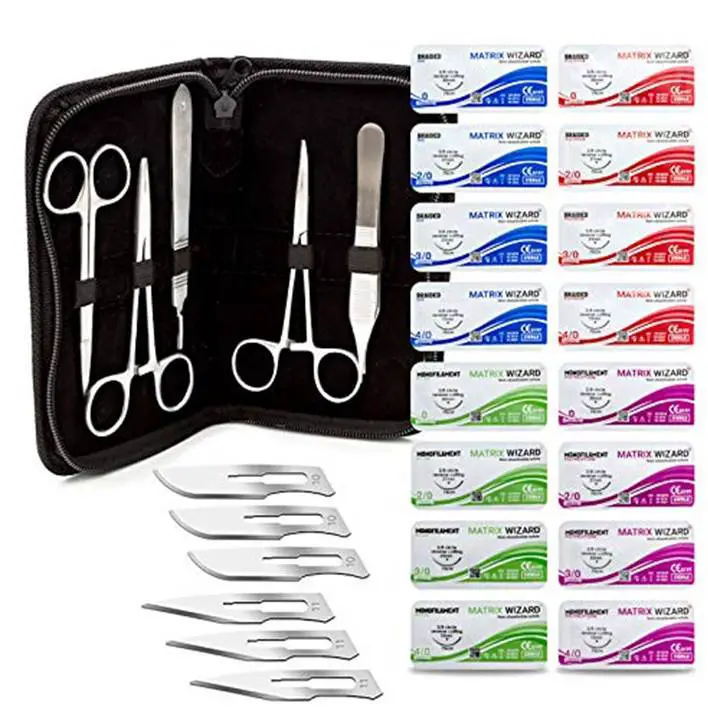
- 4 quarts Sterile Saline Solution to flush dirt or debris from wounds
- 6 – NPA Nasopharyngeal Airways to open the nasal airway and allow the victim to breathe due to shock, injury or pain
- 1 set – Surgical instruments including
- Hemostat for bullet removal
- Surgical Scissors
- Suture kit including needles and sutures
- Scalpel
- Surgical Tweezers
- Splints for arms and leg
- Liquid adhesive wound dressing
- 10 – Mylar blankets to treat for shock
- 6 – Tubes of topical antiseptic/anesthetic ointment (Neosporin)
- 300 caplets – Pain relievers like Acetaminophen Extra Strength or Ibuprofen
Pre-Packed Gunshot Wound Kits
Some people plan ahead and purchase and store specific first aid kits designed for treating gunshot wounds.

Some of the these kits are portable and have the basics while others are fully packed Tactical Combat Wound Kits. Both have sufficient supplies and equipment to deal with emergency gunshot wounds assuming you have the knowledge to use them. If you don’t have the time nor inclination to make your own you can get a fast start with one of these kits.
The only downside is they tend to have one of each item including some of the larger bandages and other equipment so you’ll either have to add additional items or assume that any gunshot wound will be a one-time event affecting ony one person. Look closely at the item list if you plan to buy a pre-packed gunshot wound kit and determine if you think it has sufficient quantities for any continued use.
Links to Online Resources for Gunshot Wound Care
These courses are easy to access and even download and store. Some are free and some charge a fee. All are worth watching and certainly worth keeping.
- American Red Cross – First Aid for Severe Bleeding Online Course
- US Lawshield – FIRST AID FOR GUNSHOT WOUNDS 90-MINUTE ONLINE COURSE
- YouTube – How to Apply First Aid to a Gunshot Wound
- YouTube – How to Use a Bullet Wound First Aid Kit
- PSC – Emergency First Aid for Gunshot Wounds
When You Have to Improvise
Maybe you didn’t have the chance or the money to buy a dedicated gunshot wound kit. Maybe you assumed your other first aid supplies would suffice only to find yourself asking, “What’s a Chest Wound Seal?” Then again, people find themselves on the road or in the middle of a bug out without many things including a kit for gunshot wounds. That’s when you have to improvise and here are some ideas for items we previously identified with links to some DIY solutions.
Tourniquet
The concept of a tourniquet is simple and they are easy to improvise if you understand the concept.
Gauze or Other Bandages
The primary benefit of gauze is that it is absorbent and sterile. If you can sterilize any fabric you can cut and improvise bandages in a variety of ways. Towels, bandanas and other naturally absorbent, cotton fabrics are best. Just make sure you wash the fabric thoroughly and try to keep it as clean as possible while drying and storing.
Surgical tape
Surgical tape doesn’t have to be white. Its primary benefit is that it releases easily while firmly holding bandages to skin. It’s also sterile but its sterility depends a lot on where and how it’s stored. All tapes have adhesive, sticky sides on the edge of the rolls. Any tape exposed to air or surfaces will pick up dirt and anything else and it will stick.
That’s why any tape that can release from the skin that has been kept packaged (germ free) can work as a replacement for surgical tape. This includes masking tape, painter’s tape, electrical tape, and even gift wrapping tape. The one tape to usually avoid is duct tape. As it is pulled from the skin it can tear open healing wounds.
Sutures
The classic suture substitute is the Butterfly bandage. It’s design is simple and once you understand the concept you can improvise sutures with butterfly bandages from any piece of tape.
Slings
Slings are usually triangular pieces of fabric and can be cut from towels, sheets, pillow cases or any other large piece of fabric, even tablecloths.
Splints
Splints can be improvised from any thin piece of wood, plastic or any other firm material that can be cut with a knife, scissors or saw. It’s essentially a support structure to prevent a limb from moving or flexing with the support of wrapped bandages.
Sterile Saline Solution
Water that has been filtered, boiled and cooled can make for an effective substitute for sterile saline. The addition of salts to the water is not necessary because it is solely used to flush and irrigate wounds before final dressings, antiseptics and bandages are applied.
Scalpel
A sterile razor blade is a good place to start if for any reason you need a scalpel. In an absolute emergency a slice of an aluminum can is surprisingly sharp.
Liquid Surgical Adhesive
This stuff is essentially super glue. A freshly opened tube of super glue should be somewhat sterile and can be used to close wounds if no other options are available.
Rolled Gauze
Rolled gauze is usually wound around deep wounds to hold bandages in place, offer support to the wounded area and also absorb excess blood. Long strips of sheets or other large swaths of fabric that have been sanitized can be cut into strips and used the same way.
Israeli Bandage
An Israeli bandage is highly absorbent and held under pressure on areas of intense bleeding. A combination of a large feminine pad and strips cut from a sheet to bind it to the wounded part of the body can present a close substitute.
Topical Antiseptic
Topical antiseptics like Neosporin can be made at home from common ingredients including medicinal plants.
It’s All About Understanding the Concept
If you understand how and why certain medical supplies and equipment work it’s much easier to improvise in an emergency. That’s why we covered the importance of medical knowledge as the first step in this article. It’s always easier to know what you need when you understand why you’ll need it. Now we can only hope that the day never comes that we need to do any of this.
Like this post? Don't Forget to Pin It On Pinterest!

